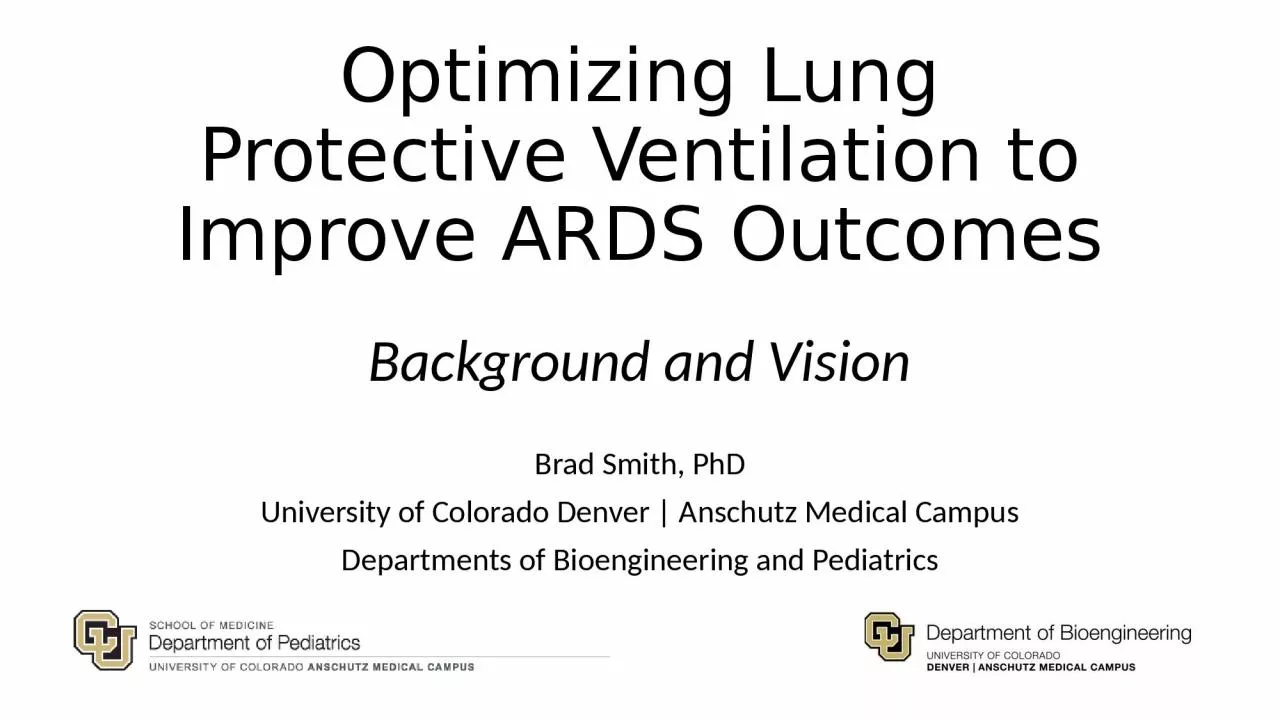

Brad Smith PhD University of Colorado Denver Anschutz Medical Campus Departments of Bioengineering and Pediatrics Background and Vision Background and Motivation Acute respiratory distress syndrome ARDS ID: 1034486
Download Presentation The PPT/PDF document "Optimizing Lung Protective Ventilation t..." is the property of its rightful owner. Permission is granted to download and print the materials on this web site for personal, non-commercial use only, and to display it on your personal computer provided you do not modify the materials and that you retain all copyright notices contained in the materials. By downloading content from our website, you accept the terms of this agreement.
1. Optimizing Lung Protective Ventilation to Improve ARDS OutcomesBrad Smith, PhDUniversity of Colorado Denver | Anschutz Medical CampusDepartments of Bioengineering and PediatricsBackground and Vision
2. Background and MotivationAcute respiratory distress syndrome (ARDS)Fluid in airspace (Edema)Surfactant dysfunction (high surface tension)Collapse of small airways and alveoli (derecruitment)Respiratory failure that requires mechanical ventilationHigh mortality and incidence~30-40% mortality~60,000 deaths/year in USA (in a normal year)Dramatic increase in ARDS due to COVID19 pandemic1m dead in USAAssuming 80% had ARDS, and 30% COVID19 ARDS mortality: 2.6m COVID19 ARDS cases!Even small improvements in survival will have huge benefitsSafe VentilationInjurious VentilationImages courtesy of G. Nieman
3. Background and MotivationARDS stiffens the lung so the patient cannot breath on their own; mechanical ventilation is requiredVentilator-induced lung injury (VILI) leads to worse outcomesMust prevent VILI to improve survivalLung protective ventilation settings are different for each patient and change over timePatient effort (ventilator dyssynchrony, VD) is also associated with worse outcomesSafe VentilationInjurious VentilationImages courtesy of G. Nieman
4. VILI: A positive feedback mechanismInitial acute injury alters lung dynamicsVentilator and patient effort cause damaging stresses/strainsRepeated collapse/reopening: atelectrauma Overdistension (volutrauma)Further degrades lung functionHow can we break this feedback loop?Optimization problem: minimize the microscale stresses/strains of ventilationSurfactant InsufficiencyRecruitment/DerecruitmentOverdistensionEpithelial/Endothelial InjuryInflammationLeak, Edema, and Surfactant Inactivation
5.
6. Some Background on the LungPrimary purpose: gas exchangeTremendously complex multiscale systemGas carried to alveoli by a branching network of airwaysBlood carried to and from the alveoli by a branching network of vessels Gas exchange occurs in alveoliAirways (white); Vessels (blue/red)
7.
8.
9. Pulmonary System ComplianceTissue : ~20% of stiffnessSurface tension forces: ~80% of stiffnessPulmonary surfactant:Dynamic reduction in surface tensionEssential to lung functionExample: premature babies with RDS (no surfactant)
10. Surfactant: Dynamic Surface Tension
11. Mechanisms of VILI: VolutraumaDamage from excess tissue stretchExacerbated by ‘Baby lung’ Effective size of the ventilated lung is reduced by collapse/floodingMore distension with the same tidal volumeParenchymal interdependenceIncreased strain from tethering forces
12. Mechanisms of VILI: VolutraumaDamage from excess tissue stretchExacerbated by ‘Baby lung’ Effective size of the ventilated lung is reduced by collapse/floodingMore distension with the same tidal volumeParenchymal interdependenceIncreased strain from tethering forces
13. Mechanisms of VILI: AtelectraumaInjury caused by cyclic collapse and reopeningSmall airways and alveoliFluid-mechanical forcesHigh pressure gradientsCell membrane stress failureHigh surface tension: more injuryInjured alveoli are more unstableThere’s both a short- and long-timescale delay!
14. Respiratory Efforts (Ventilator Dyssynchrony, VD)An added complication Clinical mechanical ventilation is messyVentilator support (breaths) commonly triggered by patient effortPatient and efforts and ventilator may be dyssynchronousMany different types (effort timing and magnitude)May cause injury depending on timing and magnitudeCan prevent VD with neuromuscular blockade (NMB)But NMB needs to be balanced against costsNeuromuscular weakness, difficulty weaning